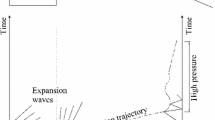Abstract
A free-piston shock tunnel (FPST) is one of the most useful ground testing facilities for hypervelocity flow research of re-entry vehicles and scramjet engines. For an efficient operation with tuned piston motion, the design of facility and the comprehension of the physical phenomena in a FPST, a numerical simulation which can properly predicts the flow with actual losses is required. But there are few successful numerical methods which can simulate its overall performance. In the present study, numerical method was developed by using the KRC shock capturing scheme and by modeling the flow losses in suitable forms for a quasi-1D numerical computation. The present numerical results were compared with the data obtained in two different facilities, T4 and T5. The applicability of the present numerical method as a design tool is discussed briefly.
Similar content being viewed by others
Abbreviations
- A :
-
Area
- C p :
-
Specific heat at constant pressure
- C f :
-
Skin friction coefficient
- L :
-
Length
- M :
-
Mach number
- N :
-
Nusselt number
- P :
-
Pressure
- P r :
-
Prandtl number
- q :
-
Heat flux per unit area
- Re :
-
Reynolds number
- T :
-
Temperature
- u :
-
Velocity
- γ:
-
Specific heat ratio
- δ :
-
Boundary layer thickness
- κ :
-
Thermal conductivity
- λ:
-
Volumetric compression ratio
- μ :
-
Viscosity
- ρ :
-
Density
- τ :
-
Shear stress
- C:
-
Compression tube
- d:
-
Downstream of the shock wave
- m:
-
Maximum value
- r:
-
Recovery
- R:
-
Secondary reservoir
- s:
-
Shock wave
- S:
-
Shock tube
- th:
-
Throat
- w:
-
Wall
References
Chinzei N, Komuro T, Kudou K, Murakami A, Tani K, Masuya G, Wakamatsu Y (1993) Effects of injection geometry on scramjet combustor performance. Journal of Propulsion and Power 9:146
Eckert ERG (1955) Engineering relations for friction and heat transfer to surface in high velocity flow. Journal of Aero Sci
Hornung HG (1992) Performance data of the new free piston shock tunnel at GALCIT. AIAA Paper 92-3943
Hornung HG, Belanger J (1990) Role and techniques of ground testing for simulation of flows up to orbital speed. AIAA 16th Aerodynamic Ground Testing Conference, AIAA 90-1377
Itoh K, Takahashi M, Hiraiwa T (1992) Pointwise non-oscillatory shock capturing scheme. In: Proc. of 6th Symposium on Computational Fluid Dynamics (in Japanese)
Jacobs PA (1993) Quasi-one-dimensional modeling of free-piston shock tunnels. 31st Aerospace Science Meeting & Exhibit, AIAA Paper 93-0352
Mirels H (1964) Shock tube test time limitation due to turbulent-wall boundary layer. AIAA Journal 2
Mitani T, Tani K, Sato S, Miyajima H, Matsumoto M, Yasu S (1992) Experimental validation of scramjet nozzle performance. AIAA/SAE/ASME/ ASEE 28th Joint Propulsion Conference and Exhibit, AIAA Paper 92-3290
Miyajima H (1991) Scramjet research at the National Aerospace Laboratory. AIAA Paper 91-5076
Miyajima H (1992) Development status of the NAL Ramjet Engine Test Facility and sub-scale scramjet engine. AIAA 4th International Aerospace Planes Conference, AIAA 92-5094
Page NW, Stalker RJ (1983) Pressure losses in free piston driven shock tubes. In: Shock tubes and waves, Proc. 14th International Symposium on Shock Tubes and Waves.
Stalker RJ (1966) The free-piston shock tube. Aeronautical Quarterly 17:351
Takahashi M, Itoh K, Ueda S, Tani K, Tanno H (1992) Numerical analysis of high enthalpy shock tunnel (real gas effects in the shock tube section). In: Proc. of 6th Symposium on Computational Fluid Dynamics (in Japanese)
Tani K, Kanda T, Kudou K, Murakami A, Komuro T, Itoh K (1993) Aerodynamic performance of scramjet inlet models with a single strut. In: 31st Aerospace Science Meeting & Exhibit, AIAA Paper 93-0741
Tani K, Ueda S, Itoh K, Takahashi M, Tanno H (1992) Numerical analysis of high enthalpy shock tunnel — design methodology. In: Proc. of 6th Symposium on Computational Fluid Dynamics (in Japanese)
Tanno H, Tani K, Itoh K, Ueda S, Takahashi M (1992) Numerical analysis of high enthalpy shock tunnel — characteristics of compression tube. In: Proc. of 6th Symposium on Computational Fluid Dynamics (in Japanese)
Author information
Authors and Affiliations
Additional information
This article was processed using Springer-Verlag TEX Shock Waves macro package 1.0 and the AMS fonts, developed by the American Mathematical Society.
Rights and permissions
About this article
Cite this article
Tani, K., Itoh, K., Takahashi, M. et al. Numerical study of free-piston shock tunnel performance. Shock Waves 3, 313–319 (1994). https://doi.org/10.1007/BF01415829
Received:
Accepted:
Issue Date:
DOI: https://doi.org/10.1007/BF01415829




